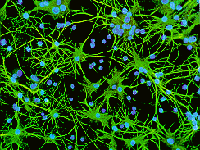Scientists edge closer to creating artificial brains
Exactly ten years ago the “father” of synergetics, the German scientist German Haken, made his prediction about the chances of creating artificial brains (electronic silicon chips joined to brain tissue). “It is an interesting task to establish a physical connection between neurons and chips,” noted Haken in his treatise ‘The principles behind the working of the brain. A synergetic approach to brain activity, behaviour and cognitive activity.’ Fromhertz, for example, is trying to solve this question… At the moment we are at the very beginning of the path, and it is difficult to make any definite predictions regarding how things will develop in the future, for example regarding chips implanted into damaged brains, and increasing the information capacity of artificial brains. Only the future will show whether we are dealing with science fiction or reality”.

But this future has now arrived. And even quicker than Haken expected…
In 2001 Peter Fromhertz and Gunther Seck from the German Makx Plank Institure of Biochemistry were the first in the world to successfully join living brain neurons to microchips built on silicon crystals. The scientists placed about 20 neurons from the cochlea onto the silicon microchip. As a result, the neighbouring nerve cells formed contacts with each other and the microchip! This hybrid of living and non-living material worked! The German biochemists then announced that they were planning to start work on creating a component made up of 15 thousand transistors.
In general this forms the impression that the story of the creation of the neuro-silicon brains is a stunning illustration of a self-fulfilling prophecy. There was a recent report, published on the site LiveScience.com saying that at Padua University in Italy a fully-fledged microchip with implanted brain cells has been constructed. The neurochip NACHIP which is about one millimeter in size contains 16,384 transistors onto which nerve endings have been attached using special proteins. The organic subsystem exchanges electronic impulses with the silicon one.
Of course, the brains of modern humans, which have been filled with thoughts of terminators and matrices, immediately produce brutal images of evil biocomputers, all-encompassing invisible webs of neurons, and cyborgs which have gone on a rampage. But it would seem as if in the near future the real use of artificial brains will be purely limited to medicine.
“It is really interesting news,” stressed Elena Loseva, a doctor of biology, and head of the laboratory for functional neuromorphology at the Institute of Upper Nerve Activity and Neurophysiology. “As I understand it, for the moment this chip is in contact with cultured neurons. And the medicines are also being tested in the culture. In my view it would be extremely important to implant these microchips into a living brain using pathology or into neuron tumors and check what effect the medicines have on specific targets. After all the interactions of cells and brain matter differ greatly from those interactions which take place in a culture. These chips, which have been implanted into a functioning brain, could bring us closer to understanding the cellular and molecular mechanisms which make the brain work. Furthermore, this research can be carried out on a living organism which is the main difference with most research done in the field of modern neurobiology.”
Incidentally, the cofounder and leading scientist for the company Sun Microsystems Bill Joy warned in the March 2000 issue of the magazine Wired that a combination of genetic engineering and computer technology carries a very real threat to mankind and the ecosystem. According to him, the latest achievements in the realm of molecular electronics mean that by 2030 “we will probably be able to create machines which are a million times more powerful than modern personal computers” and give them a human level of intellect. “The instruments which I have created could perhaps help to build technology which will take the place of our biological form. That really is a terrifying thought,” he said.
Source: Nezavisimaya Gazeta
Translated by James Platt
Subscribe to Pravda.Ru Telegram channel, Facebook, RSS!




